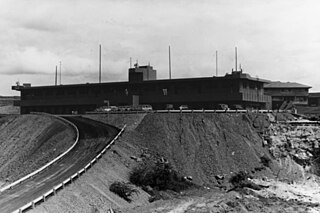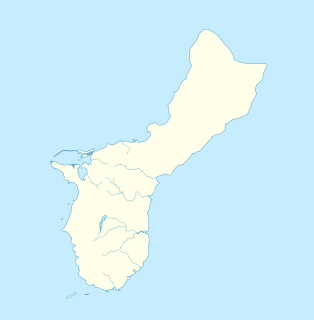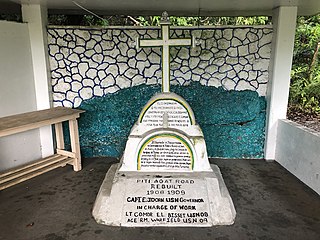
CINCPAC Fleet Headquarters, also known as Commander in Chief Pacific Fleet Headquarters or COMPACFLT Headquarters, is a historic military building on Makalapa Drive in Joint Base Pearl Harbor–Hickam, on the island of Oahu in the US state of Hawaii. Built during World War II in 1942, it served as the headquarters of Admiral Chester W. Nimitz from 1942 through 1945, while he was Commander-in-Chief, Pacific Fleet and Commander-in-Chief, Pacific Ocean Areas, during World War II. Commanding land, sea, and air forces, Admiral Nimitz had major responsibility for campaigns such as the Battle of Midway, the liberation of Guam, and the seizure of Saipan and Tinian in the Marianas. It was designated a National Historic Landmark for this role in 1987.

The Merlyn G. Cook School, also known as the Merizo School, is a historic former school building on GU 4 in Merizo, Guam. Built sometime before 1931, it is one of the first schools built during the administration of the island by the United States Navy. Its construction methods are transitional, including both traditional Chamorro-Spanish methods and period American methods. A series of concrete pillars provide the main structure, with the flooring substructure and wall framing of insect-resistant ifil wood. The windows are covered with rare ifil-wood shutters that pivot horizontally. The building's interior is clad in wood planking typical of early 20th-century Chamorro construction. The school has long served as a community meeting point, and was used as a place of refuge during World War II.

The Guam Congress Building, also known as the Guam Legislature Building, is the seat of the Legislature of Guam and is located in Chalan Santo Papa in Hagåtña, Guam. It was built in 1949 by Pacific Island Buildings and of Brown & Root Pacific Bridge & Maxon. It has served as a capitol and as a courthouse building. It is a Modern Movement-style building that was listed on the U.S. National Register of Historic Places in 2007.

The Tinta Massacre Site, near Merizo, Guam, has significance from 1944. Also known as Tinta (66-06-1223), it was listed on the National Register of Historic Places in 1991. The listing included one contributing site and one contributing object.

The Merizo Bell Tower, on Guam Highway 4 in Merizo, Guam, is a bell tower that was built in 1914 or 1919. It was listed on the U.S. National Register of Historic Places in 1975.

The Mataguac Hill Command Post, near Yigo, Guam, has significance from 1944 during the Battle of Guam. It was the location of "the last organized resistance by the Japanese to the American liberation of Guam during World War II and therefore is considered a highlight of the invasion of Guam."

The Atantano Shrine is a historic commemorative marker near Piti, Guam. It is a pyramidal structure of coral limestone and concrete, about 2.5 metres (8.2 ft) in height, with base dimensions of 1.6 metres (5.2 ft). It is topped by a wooden cross and protected by an open concrete shelter. The monument was built in at least three stages, the early stages acting as bases for the mounting of the later ones. Panels on three sides carry inscriptions. The oldest inscription marks the initial construction of the road between Piti and Agat under the governorship of Don Felipe Cerain in 1784–85. The second inscription commemorates the creation of rice fields in the area under by Governor Don Francisco Villabos in 1832–34, and the third marks the reconstruction of the coast road during the governorship of Edward John Dorn in 1908–09. Commemorative markers of this type were a fixture of Spanish colonial administration that were adopted by Guamanians. The shrine has been the site of annual festivities since before World War II.

The Agana Historic District in Hagåtña, Guam is a 2-acre (0.81 ha) historic district that was listed on the U.S. National Register of Historic Places in 1985. It includes five contributing buildings: the Calvo-Torres, Rosario, Martinez-Notley, Lujan and Leon Guerrero houses. The area is roughly bounded by 2nd S., 3rd S., and 9th W., Santa Cruz and Legaspi Sts. in Agana.

The former Japanese Hospital building on the island of Rota in the Northern Mariana Islands is one of the few remaining Japanese-era buildings on the island. It is a single-story L-shaped concrete structure. When listed on the National Register of Historic Places in 1981, it was described as being in derelict condition, being little more than the concrete structure, lacking a roof, windows, and most of its woodwork. The window openings are sheltered by typical Japanese concrete canopies. The building was built by the Japanese about 1930, during the South Seas Mandate period; most Japanese-built structures on Rota were destroyed during World War II.

The Baza Outdoor Oven is a 20th-century version of a traditional hotnu, or outside oven, on the island of Guam. This oven is located at the end of Beatrice Baza Drive in the village of Yona. It was built in 1952 out of brick and concrete, but is based on traditional forms that have been in use on Guam since they were introduced by the Spanish in the 17th century. It is a barrel-shaped structure about 2 metres (6.6 ft) long, 1.5 metres (4.9 ft) wide, and 1.67 metres (5.5 ft) high. The base of the structure is poured concrete about 0.6 metres (2.0 ft) high, with the vaulted portion about 1 metre (3.3 ft) high. The interior of the vault is made out of heat-resistant bricks, while the exterior is finished in cement. The oven was used by heating it until the bricks were white, after which the burning materials were removed, the food to be cooked was added, and the main door was closed. This oven is large enough to roast four pigs.

The Agana-Hagåtña Pillbox is a former Japanese defensive fortification in Hagåtña, Guam. It is a six-sided reinforced concrete structure, located a short way above the high-tide line on the west side of the Paseo de Susana, a small peninsula jutting north from the village center. There is another wall providing cover for the entrance on the land side. The interior is divided into two chambers, each of which has a gun port. The structure was built by Guam's Japanese defenders during their occupation of the island (1941–44) in World War II.

The Faha Massacre Site is located just behind the Pigua cemetery in the village of Merizo on the United States island of Guam. The site is demarcated by four concrete pillars, connected by metal cables, with several crosses placed inside that area. A metal plaque mounted on a concrete block commemorates the thirty native Chamorro men who were slaughtered here on July 16, 1944, by members of the Imperial Japanese Army (IJA) during the Japanese occupation of the island during World War II. The IJA routinely forced Guam's native population to work on its construction projects. The men who were killed here were rounded up for a work crew; why they were killed is unclear, as there were no survivors. The massacre took place one day after the Tinta Massacre, and about one week before the liberation of the island began.

The Malessu' Pillbox is a World War II-era Japanese-built defensive fortification on the shore of Merizo, Guam. Located about 15 metres (49 ft) from the high-tide line at Merizo Beach, it is a rectangular structure built of steel-reinforced concrete and basalt rock. It is 3.9 metres (13 ft) deep, 2.4 metres (7.9 ft) wide, and about 2.42 metres (7.9 ft) high, although only about 0.75 metres (2.5 ft) of the structure is visible above ground. Its gun port has a view of the Merizo pier, and is approximately at ground level. It was built by Japanese defenders during their occupation of the island 1941–44.

The Malesso Japanese Rice Mill is a historic World War II-era storage building in Merizo, Guam. It is a single-story concrete structure with two rooms, located on a small parcel in a residential area south of Guam Highway 4 off Barcinas Road. The concrete was made of locally sourced aggregate and lime. It was completed on December 24, 1943, by conscripted Chamorro labor working for the occupying Japanese authorities. It was built as part of a project by the Japanese to improve rice production in the area during the later period of the occupation. There is no evidence that the building was intended to house facilities for milling rice, although it has always been referred to locally as a rice mill. It is the only known non-military structure to survive on the island from the Japanese occupation period.

The Mana Pillbox is an old World War II-era Japanese-built defensive fortification on the east coast of the island of Guam. It is located south of the village of Talofofo, about 50 metres (160 ft) inland from the point marking the south end of As Anite Cove. It is a structure built out of coral limestone and concrete, with an interior chamber about 3 by 1.8 metres in size. The entrance is on the south side, measuring 0.85 by 1.45 metres. There is one gun port, facing north, measuring 0.32 by .9 metres. The structure was designed to be well hidden in view from the sea and air. It was built, probably by conscripted Chamorro labor, during the Japanese occupation period 1941–44.

The Mount Tenjo Fortifications are a historic defensive gun battery site on Mount Tenjo, a hill overlooking Apra Harbor, the principal deep-water port on the island of Guam. The site includes concrete mounting pads for seven guns and the crumbling remains of a concrete command post structure. These facilities are located just below the crest of the hill on its west side. A defensive trench also extends along the top of the plateau-like hill. Unlike most early 20th-century fortifications on Guam, these facilities were built in the late 1910s by the United States Navy, and not by Japanese forces during the World War II occupation period. These are the only known surviving pre-World War II defensive fortification sites on the island. They were functionally abandoned as a result of the 1922 Washington Naval Conference. Mount Tenjo was the site of battle during the 1944 liberation of Guam.

The Quan Outdoor Oven is a 20th-century version of a traditional hotnu, or outside oven, on the island of Guam. This oven is located on Quan family land on J. C. Santos Road, south of Santos Memorial Park in Piti. Although built out of modern materials, it follows a traditional form that has been in use on Guam since these ovens were introduced by the Spanish in the 17th century. It is a barrel-shaped structure about 2 metres (6.6 ft) long, 1.68 metres (5.5 ft) wide, and 1.37 metres (4.5 ft) wide, rising to a height of 0.64 metres (2.1 ft). The base of the structure is either poured concrete or concrete blocks. The interior of the vault is made out of heat-resistant bricks, while the exterior is finished in concrete. When recorded in 2010, its main opening was damaged.

The San Vitores Beach Japanese Fortification are the remains of World War II-era defensive positions facing the beach of Tumon Bay on the west side of the island of Guam. Located near the stairs to the beach of the Guam Reef Hotel are the remains of two concrete pillboxes built by Japanese defenders during the occupation period 1941–44. One structure, of which little more than a gun embrasure is discernible, is located in the limestone cliff about 10 metres (33 ft) inland from the high tide line, and a second is located about 10 meters south and 8 meters further inland, with only a section of roof slab and supporting columns recognizable.

The Talofofo Pillbox is a historic World War II-era defensive fortification in Talofofo, Guam. It is located near the coast, about 127 metres (417 ft) south of the mouth of the Togcha River and 27 metres (89 ft) inland from the high-tide line. It is roughly 2.75 by 3.0 metres, built out of concrete and coral limestone. Its walls are about 0.5 metres (1.6 ft) thick, with an embrasure providing a view of the Togcha River, and a window looking over the coast to the east. Its entrance is on the landward (south) side. This structure was built under the direction of the Imperial Japanese Army during its occupation of Guam in 1941–44.

The Tokcha' Pillbox is a Japanese-built World War II-era defensive fortification on the island of Guam. It is built on a limestone terrace on Togcha Point, about 1 mile (1.6 km) north of the Togcha River and 0.7 miles (1.1 km) south of the Ylig River. It is set in a depression excavated from the limestone about 15 metres (49 ft) inland from the high tide land and 1 metre (3.3 ft) above sea level. It is a roughly rectangular structure built out of steel-reinforced concrete filled with coral and beach aggregate. The entrance is on the north wall, sheltered by a wall of coral blocks, and the gun port is on the south wall. This structure was built under the direction of the Japanese military during their occupation of the island 1941–44.







